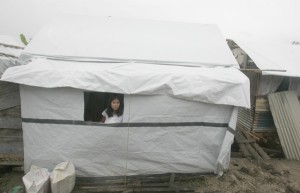MALACAÑANG on Sunday admitted that the government has been unable to adequately address the needs of the millions of people affected by Super Typhoon Yolanda.
But Presidential Communications Secretary Herminio Coloma Jr. said government is determined to push ahead with the rehabilitation of all 171 municipalities and cities hit by the calamity.
“We realize that despite its best efforts, government is unable to adequately respond to all the needs of all the affected families and individuals. We continue to welcome suggestions on how we can improve our response and assistance,” Coloma said in a statement.
He vowed that families living in bunkhouses and temporary shelters will be provided permanent housing in new settlements with facilities for livelihood activities.
“New school buildings, municipal halls, public markets, and town centers will be constructed,” he said.
The United Nations confirmed on Sunday that 100 days after the super typhoon hit the Central Philippines, “needs remain enormous.” It called on government and aid agencies not to be complacent and to find ways to house those still without roofs over their heads.
“The need for durable shelter for millions of people whose homes were damaged or destroyed is critical,” said UN resident humanitarian coordinator Luiza Carvalho.
She said 45 percent of the $788 million appeal the UN had launched had already been received, and it had benefited hundreds of thousands.
Some half a million families had already received tents and tarpaulins for temporary shelters, while emergency jobs programs helped put money in survivors’ pockets and revive local economies.
Carvalho said millions of jobs were destroyed or impaired after Yolanda tore down or damaged 33 million coconut trees, flooded fields with salt water, and swept away or wrecked 30,000 fishing vessels.
According to Coloma, President Benigno Aquino 3rd has directed members of the Cabinet to prepare a detailed roadmap for effective response to disasters before the onset of the rainy season in June.
“This will include adoption of new emergency alert protocols for storm surge, floods, and landslides; strict implementation of no build zones along coastlines; and higher standards for disaster resiliency of buildings and infrastructure,” he said.
Learning from Yolanda’s lessons, the government will give priority to setting up an all-weather communications system including satellite phones and mobile communications kits to ensure uninterrupted connectivity despite power service interruption.
“As we stated in the Asean-Japan Commemorative Summit last December 2013, the Philippines and other disaster prone countries must break the cycle of prediction, devastation, and rehabilitation by adopting the principle of build back better and being more productive. The President has also said that, with the worsening effects of climate change, we must make even greater measures to adopt including reinforcing our supply of power,” Coloma said.
He also promised to act on reports of abuse or anomalies in the provision of relief services to victims of calamities. Coloma called on all Filipinos to continue working with government and all donor and aid agencies in extending a helping hand to the victims.
“In order to build back better, reconstruction and rehabilitation must be needs-based and grounded on concrete realities at the grassroots level. For this reason, Secretary Panfilo Lacson has prioritized local government units that have done their homework in preparing a post-disaster needs assessment analysis and corresponding rehabilitation plan,” Coloma said.
Security is another serious concern for millions of displaced people, according to the United Nations High Commissioner for Refugees (UNHCR).
Joel Andersson, head of Yolanda Operations for UNHCR in Tacloban City, said among the lingering issues are a heightened risk of human trafficking, sexual and gender-based violence and child exploitation.
Andersson said particularly vulnerable are the elderly, persons with disabilities and indigenous groups who lost their homes and livelihood.
He said the UNHCR has been heavily involved in training local authorities, aid workers, the military and the police on the UN Guiding Principles on Internal Displacement, child protection and sexual and gender-based violence together with the other members of the Protection Cluster.
“Through this, we have a dialogue with national protection actors on how to bring a human rights perspective into the emergency response and search for solutions for the most vulnerable populations,” he said in a statement.
The UNHCR, under the Typhoon Yolanda Protection Cluster led by the Department of Social Welfare and Development, has supported the strengthening of the Women and Children’s Protection Desks of the Philippine National Police to improve security for women and children survivors.
It supported the deployment of dozens of female police officers from other regions to typhoon-stricken areas, installation of teams in disaster areas to monitor all forms of movement of those displaced by the typhoon, including relocation and resettlement, and ensure that these are voluntary, safe, free, informed and dignified.
“We will continue to work with the government to help deliver durable solutions to the millions displaced and affected by the super typhoon, with a protection focus,” Andersson said.
WITH AFP


